Contributory members are able to log private notes and comments about each site
Sites Anne T has logged. View this log as a table or view the most recent logs from everyone
St Anne's Well (Cotehill)
Trip No.146 Entry No.3 Date Added: 28th Aug 2019
Site Type: Holy Well or Sacred Spring
Country: England (Cumbria)
Visited: Yes on 27th Aug 2019. My rating: Condition 3 Ambience 3 Access 4
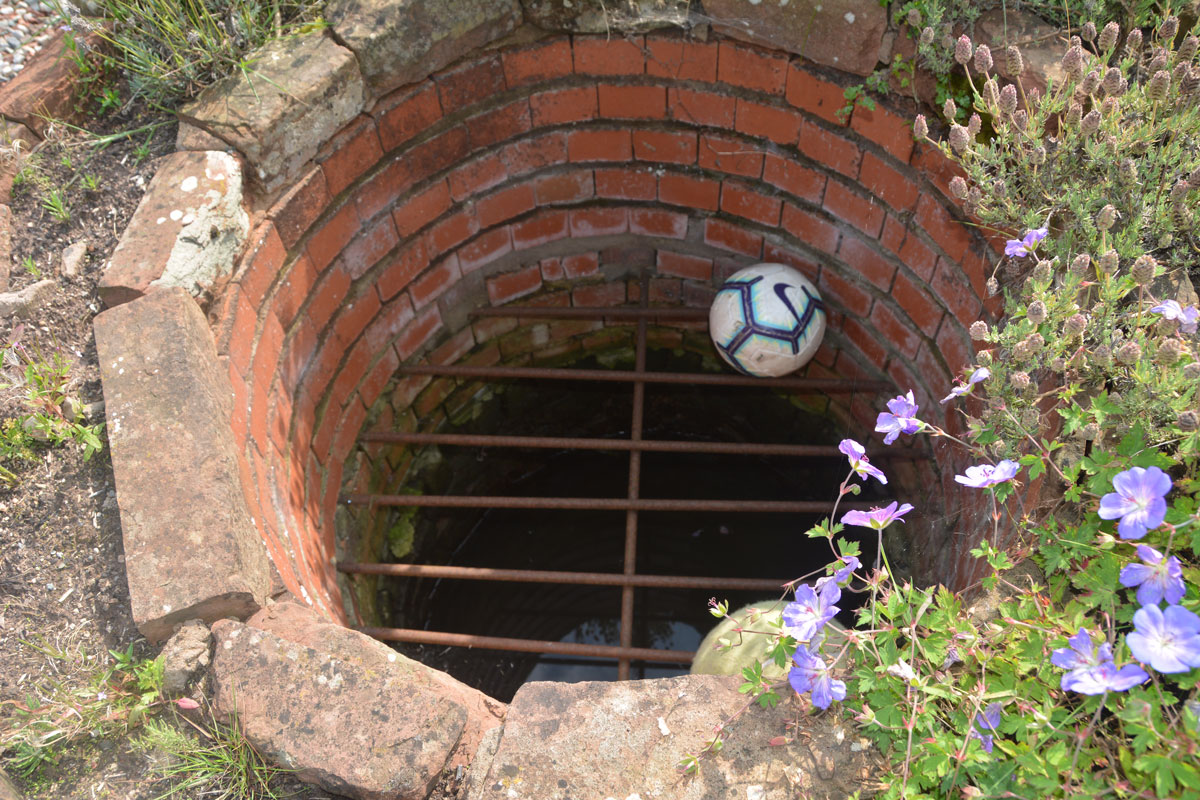
St Anne's Well (Cotehill) submitted by Anne T on 28th Aug 2019. Taking a closer look, there is a proper, brick-lined well, topped with a substantial metal grille.
(View photo, vote or add a comment)
Log Text: St Anne's Well, Cotehill: We squeezed on the odd little road junction that led to a small, new housing development, under the footpath sign.
We followed the footpath sign, which led straight through someone’s garden. We got a bit lost at this point, as several tracks through the grass had been mown flatter than others. Andrew followed two of them but could not see the well structure at all. As we were standing looking more closely at the map, the lady of the house and her children came out. I asked her if she knew where St. Anne’s Well was, and she said she had never heard of it.
Looking more closely, Andrew said the circle for the well was on the edge of the courtyard enclosed by the houses, before the footpath went through the garden of the house, so we retraced our steps a few metres.
There, in the house to our right hand side (facing the footpath and the meadows/open farmland beyond), was a circular brick flower bed. Andrew pronounced “that’s it”. I said ‘surely not’.
The structure was about 10m on private property within the garden, and I was to go up and knock on the door of the house and ask for permission to take photographs, but there no signs of life. “Who can run quickest?” I asked Andrew jokingly, and took a few steps into the garden, feeling very guilty.
There, inside the circular brick structure was a heavy iron grate, with a pool of water inside. This was definitely a well. I took three photographs very quickly, retreating back to the courtyard.
No mention in Pastscape or Historic England, although the well is shown as a blue circle on the HE map.
St Cuthbert's Well (Clifton)
Trip No.146 Entry No.4 Date Added: 29th Aug 2019
Site Type: Holy Well or Sacred Spring
Country: England (Cumbria)
Visited: Yes on 27th Aug 2019. My rating: Condition 3 Ambience 3 Access 5
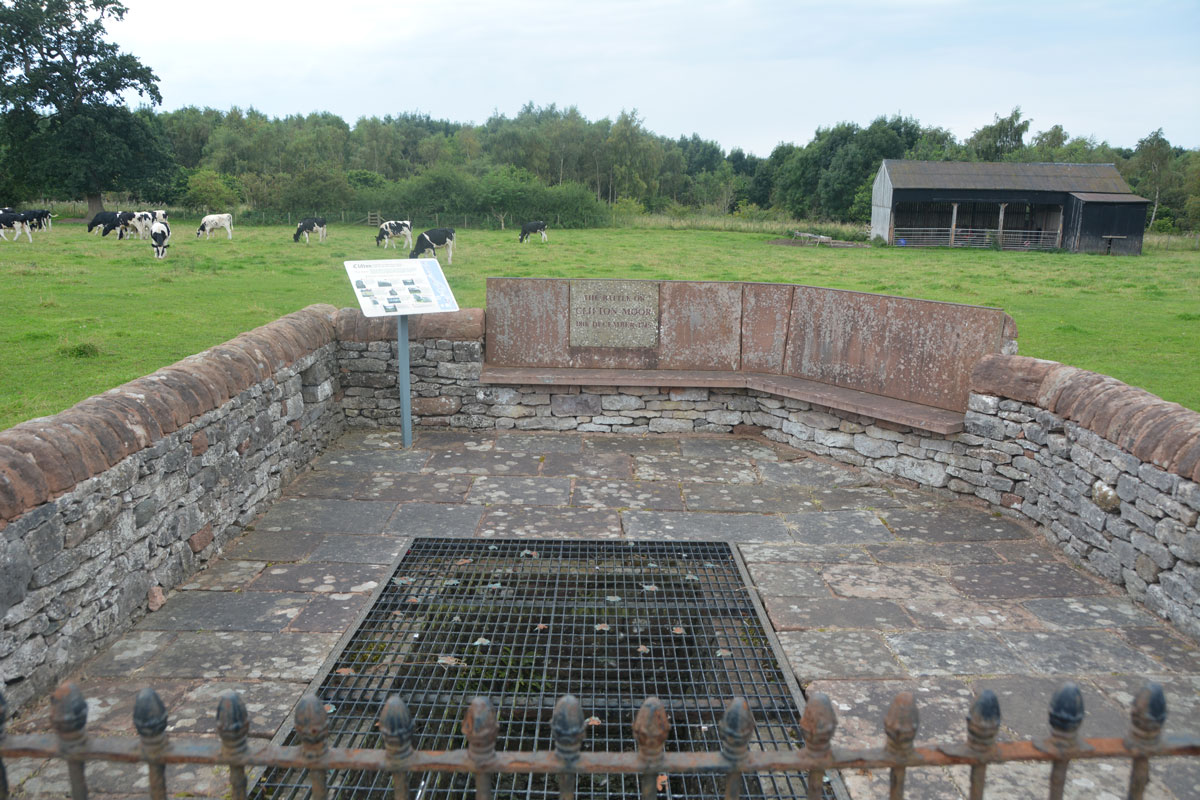
St Cuthbert's Well (Clifton) submitted by Anne T on 29th Aug 2019. The spring/well now covered by a close metal grille, which made taking photographs of the steps and water channel somewhat difficult, despite using manual focus. The enclosure commemorates the last battle on English soil between the Jacobite army and Government troops on 18th December 1745.
(View photo, vote or add a comment)
Log Text: St Cuthbert's Well (or Kelter Well), Clifton: The enclosure for this well is to the western side of the A6, towards the southern end of Clifton village. In some ways, this well is very disappointing, as the grid over it does not allow you to see very much, apart from some stone steps leading down to what appears to be a culvert with a strong flow of water running through it.
The well has been built into an enclosure which commemorates the last battle on English soil between the retreating Jacobite army and Government troops. This took place on 18th December 1745 (the battle of Clifton Moor).
No entry on either Pastscape or Historic England, although a well is shown on their map if you enter the grid reference above.
Eye Keld Well
Trip No.146 Entry No.5 Date Added: 29th Aug 2019
Site Type: Holy Well or Sacred Spring
Country: England (Cumbria)
Visited: Yes on 27th Aug 2019. My rating: Condition 2 Ambience 3 Access 4
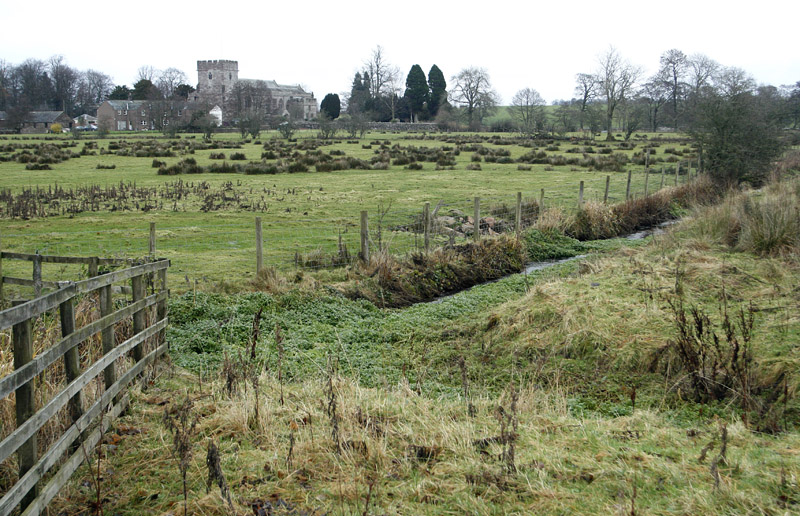
Eye Keld Well submitted by MisterBus on 28th Nov 2010. Eyekeld well, Greystoke, Cumbria, UK. The spring is in the foreground but is a neglected state. In the background is St Andrews Church, Greystoke
(View photo, vote or add a comment)
Log Text: Eyekeld Well, Greystoke: On the eastern side of the B5288 Icold Road which runs south from the village centre. The spring is only visible by peering over the dry stone wall, and the channel is covered with weeds and bracken, although there is a plentiful supply of water running from it, judging by the sounds of trickling water. There is also a long, straight water channel which runs east from the spring.
The Springs of Living Water, page 22 (with a photograph on page 25) has a couple of references to two wells in Greystoke, telling us they are dedicated to St Kentigern (aka St Mungo):
“The site of the well at Greystoke is on the roadside when entering the village from the south. This could well have been the place of a preaching stop … There was a well to the north of Greystoke, called Thanet Well after the name of St. Kentigern’s mother St. Tenue. The well is now covered by a concrete slab in a barn/garage belonging to the house next to the holiday park. The name of the well is preserved in the name of the park”.
In McIntire's "Holy Wells of Cumbria", he mentions a visit by Bishop Nicholson on 26th July 1705: "In ye morning we walk'd out to view (and taste) several extraordinary springs about the Town of Greystock; one of which they call Eye-Keld, Mary-Keld, Tolly-Keld." McIntire notes: "Eye Cold Spring still exists as Icold spring; "Mary-Keld" has had its name corrupted to Marigold. It rises in the park. "Tolly Keld" is a small stream discharging into the Petteril."
Borrowdale Stone Monument
Trip No.155 Entry No.1 Date Added: 15th Jan 2020
Site Type: Standing Stones
Country: England (Cumbria)
Visited: Yes on 12th Jan 2020. My rating: Condition 3 Ambience 4 Access 3
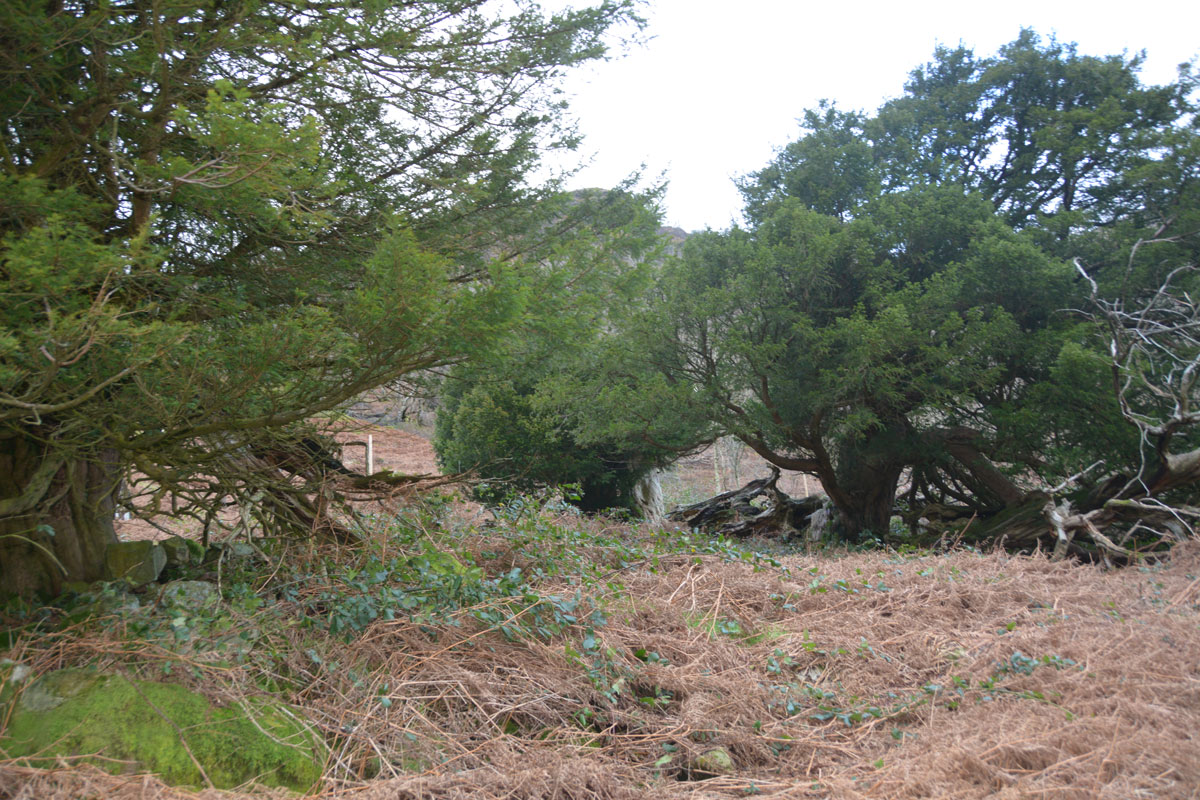
Borrowdale Stone Monument submitted by Anne T on 15th Jan 2020. Some of the smaller boulders have been cleared and piled up around the base of these ancient yew trees. Certainly very impressive trees and very old indeed. Well worth a visit. Photograph by Andrew T.
(View photo, vote or add a comment)
Log Text: Borrowdale Yews and the possible stone monument: Our first trip out for several months, and a way of escaping the windy and wet weather here in Northumberland. However, we arrived in a Cumbria that had experienced very heavy rain over recent days, and the small stream were swollen and many of the roads were flooded, although still passable.
We parked in the small car park near Seathwaite Farm, which is also a camping site and walked through the fields to the two bridges crossing the river(s). There are also a number of other streams to be crossed between here and the yew tree enclosure; at times of dry weather these would be easy to cross. On this occasion, a bit of balancing on convenient ‘stepping stones’ was in order!
The slope up to the yew tree enclosure was very slippery, so I sent Andrew up with the camera to explore. He came back saying the stones are definitely aligned in what seems to be a row, although I remained very sceptical, as there are a huge number of other boulders (large and small) on the hillside. Looking at the site from the south of river, by the car park, there seems to be the remains of the lower half of a double stone circle to the south west of the yew tree enclosure, although this could also just be coincidence.
This area was very heavily mined for graphite from 1555 onwards, and the remains of some of the industrial buildings can still be seen.
Sorry, but I remain unconvinced this is a stone row or alignment – there were so many other short rows of seemingly aligned stones on the hillside, this seemed like coincidence to me.
Bowder Stone
Trip No.155 Entry No.2 Date Added: 15th Jan 2020
Site Type: Natural Stone / Erratic / Other Natural Feature
Country: England (Cumbria)
Visited: Yes on 12th Jan 2020. My rating: Condition 3 Ambience 4 Access 4
Bowder Stone submitted by maigo on 25th Jun 2013. May2009
(View photo, vote or add a comment)
Log Text: The Bowder Stone, Borrowdale: We parked in the car park (there is a small charge) and walked the quarter of a mile to this enormous boulder. The last time we came here, some time ago, we walked through the quarry and I remember photographing all the old tree roots emerging from the rock and forming strange and complex patterns. Not so now, a recent path runs uphill, following the western side of the boundary for the quarry.
As usual, there was a party of young people, complete with mattresses, bouldering underneath the overhang. It was amusing to stand and watch them, although some of the tumbles looked a bit painful.
Andrew headed up the ladder to the platform at the top, whilst I wandered round the other side of the stone, a megalith catching my eye.
Askham Fell Cairn Stone Row
Trip No.173 Entry No.4 Date Added: 16th May 2022
Site Type: Stone Row / Alignment
Country: England (Cumbria)
Visited: Yes on 14th May 2022. My rating: Condition 3 Ambience 4 Access 4
Askham Fell Cairn Stone Row submitted by SandyG on 7th Jan 2018. The two western stones and nearby kerbed cairn. View from south (Scale 1m).
(View photo, vote or add a comment)
Log Text: Askham Fell Cairn and stone row: Using M. Waistell Taylor's Antiquarian paper from 1885, plus Sandy Gerrard's notes from the Stone Rows of Great Britain, we parked at the end of a row of cars at the junction of the single track road and the footpath which runs across it, near the Cop Stone. We set off with our trusty GPS to walk up to this amazing cairn to find the associated stone row.
We've visited this area before (28th June 2014), but more recently, Sandy G has been along to this area and surveyed the 2 verified stone rows in this area. We were unable to join him on this survey, but we're curious to find out more.
Thankfully we had Sandy G's diagram of the 4 small stones in this row (I thought they were just part of the kerb). Andrew very gracefully modelled the location of the smaller 2 stones using my walking poles.
Given the number of walkers around, I was amazed how many people were sticking to the paths and bridleways, rather than look at the archaeology. So much to see in such a concentrated area.
Cop Stone
Trip No.173 Entry No.3 Date Added: 17th May 2022
Site Type: Standing Stone (Menhir)
Country: England (Cumbria)
Visited: Yes on 14th May 2022. My rating: Condition 3 Ambience 4 Access 4
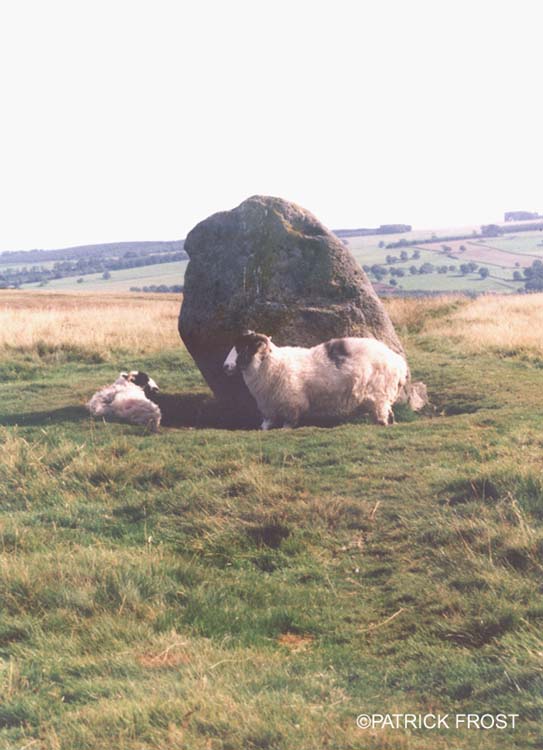
Cop Stone submitted by Patrick Frost on 14th Oct 2002. The Cop Stone in Cumbria at GR: 496216
(View photo, vote or add a comment)
Log Text: The Cop Stone, Askham Fell: Our second visit to this area, which has a wealth of archaeological sites, and reminds me very much of Dartmoor (in places). The weather was gloriously hot, and with many other walkers on the moor, we joined the row of cars parked by the side of the road at around NY 49586 21586.
Nothing much has changed about the Cop Stone since our last visit in 2014, although I was amazed at the number of people who just walked straight on by, without stopping. I had forgotten that the Cop Stone lies on the South Eastern border of a ring cairn, which has been described and illustrated by W. Waistell Taylor in his 1885 Antiquarian paper "Prehistoric Remains on Moordivock". Most of the stones in the ring are largely hidden, or just peeping above, the turf.
Fairy Well (Aikton)
Date Added: 4th Jun 2022
Site Type: Holy Well or Sacred Spring
Country: England (Cumbria)
Visited: Yes on 14th Jun 2020. My rating: Condition 2 Ambience 1 Access 5

Fairy Well (Aikton) submitted by Anne T on 4th Jun 2022. Parking at the side of the small road running west-east past the site of this well, referring to the old OS map from the National Library of Scotland, the well is located where the white arrow is pointing - in a ditch, but well hidden by both the hedge and the surrounding foliage.
(View photo, vote or add a comment)
Log Text: Fairy Well (Aikton): just after lockdown rules were relaxed marginally, and it was possible to travel short distances for reasons other than work or exercise, we needed to travel very near to Aikton, so took a short detour to try and find this well. There were plenty of walkers and other cars, but, as defined by lockdown law, no shops open, and no well to find!
Actually, not quite true, as peering down into the ditch, some water was visible bubbling up from the ground, running along a ditch to the south side of the hedge running along the northern edge of the field, but it was very difficult to find.
The gate into the field was open, so we looked along the other side of the hedge - all we could see were huge lumps of stone and concrete, which had been dumped along the ditch-line. Apart from a large lump of stone by the field gate, which looked as if it had simple architectural carving on it.
St Cuthbert's Stone and Well (Waverbridge)
Date Added: 4th Jun 2022
Site Type: Holy Well or Sacred Spring
Country: England (Cumbria)
Visited: Yes on 14th Jun 2020. My rating: Condition 2 Ambience 3 Access 4
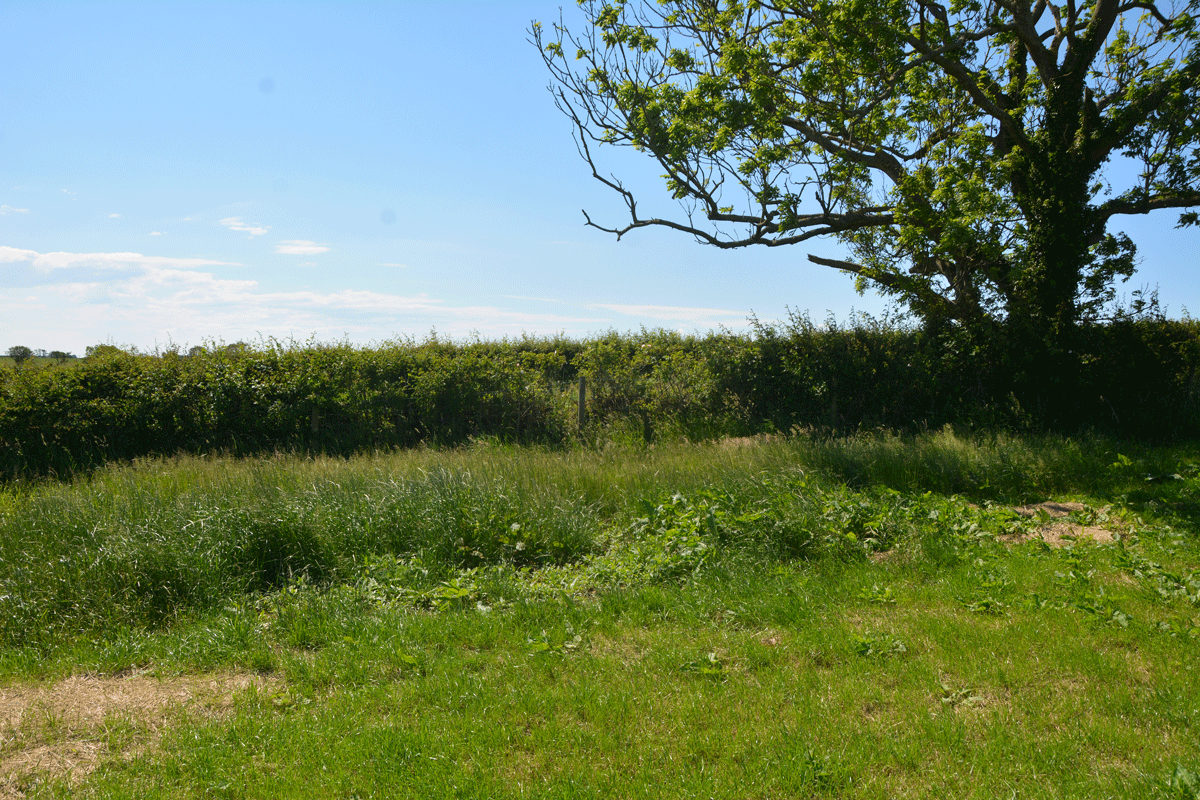
St Cuthbert's Stone and Well (Waverbridge) submitted by Anne T on 4th Jun 2022. Looking at the un-mown section of grass where the site of the well is shown. No water was showing in the field, but there was a pipe under the roots of the tree leading into the drainage ditch at the far side of the tree in the photograph.
(View photo, vote or add a comment)
Log Text: St Cuthbert's Stone & Well: We were making our first (and only for a long time) essential trip out, and passed within 400m of this well, so screeched to a halt at the entrance to the track (Watergate Lonning) at its junction with the B5302 at NY 21277 49139, and took our daily exercise walking down slope towards the well.
There is some sign of the well - in the field as an un-mown area of grass and in the hedge-line under the tree are remnants of a stone structure between the tree roots and along the bank of the ditch. All along the left hand side of the track (eastern side) is a drainage ditch, which we presume took the water from the fields, then when you get to the well, the water from the well joins the ditch. The well was dry at the time of our visit.
The stone was marked on the OS map, but was several fields away, with no gates in sight, so with time pressing, I photographed the well and we set off for our destination. So very odd to be out-and-about after months at home, but lots of other cars on the road, and difficult to rejoin the main road due to the high speed traffic.
St Mary's Well (Heversham)
Trip No.179 Entry No.4 Date Added: 22nd Jun 2022
Site Type: Holy Well or Sacred Spring
Country: England (Cumbria)
Visited: Yes on 21st Jun 2022. My rating: Condition 3 Ambience 3 Access 4
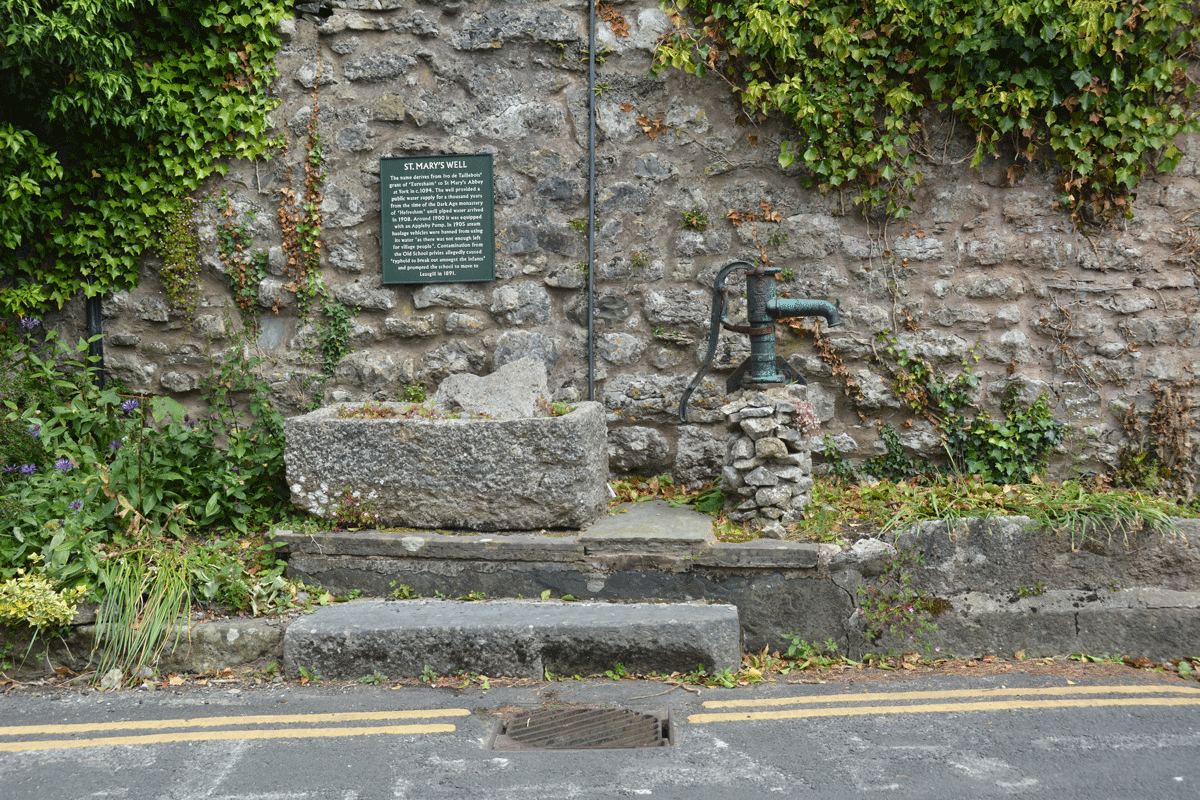
St Mary's Well (Heversham) submitted by Anne T on 22nd Jun 2022. Standing across the road from the well, looking at the pump and well trough (both now appear to be dry).
(View photo, vote or add a comment)
Log Text: St Mary's Well, Heversham: Spotted the blue 'W' on the HE map search when looking up information for St Peter's Church, so decided to have a look. Actually found the well purely by chance, when we drove past looking for a parking spot, then doubled back and parked near the lych gate, walking back to the well after we'd photographed the Anglo-Saxon stone fragments.
Having escaped the noise of building work (and radios) at home, we arrived to find the builders in the house opposite the well blasting out very loud rap music. Not a great visit as a result, as we couldn't hear ourselves think, but good to have added another well to the list I've seen.
St Michael's Well (Shawk)
Date Added: 10th Jul 2022
Site Type: Holy Well or Sacred Spring
Country: England (Cumbria)
Visited: Yes on 25th Jun 2020. My rating: Condition 3 Ambience 3 Access 3
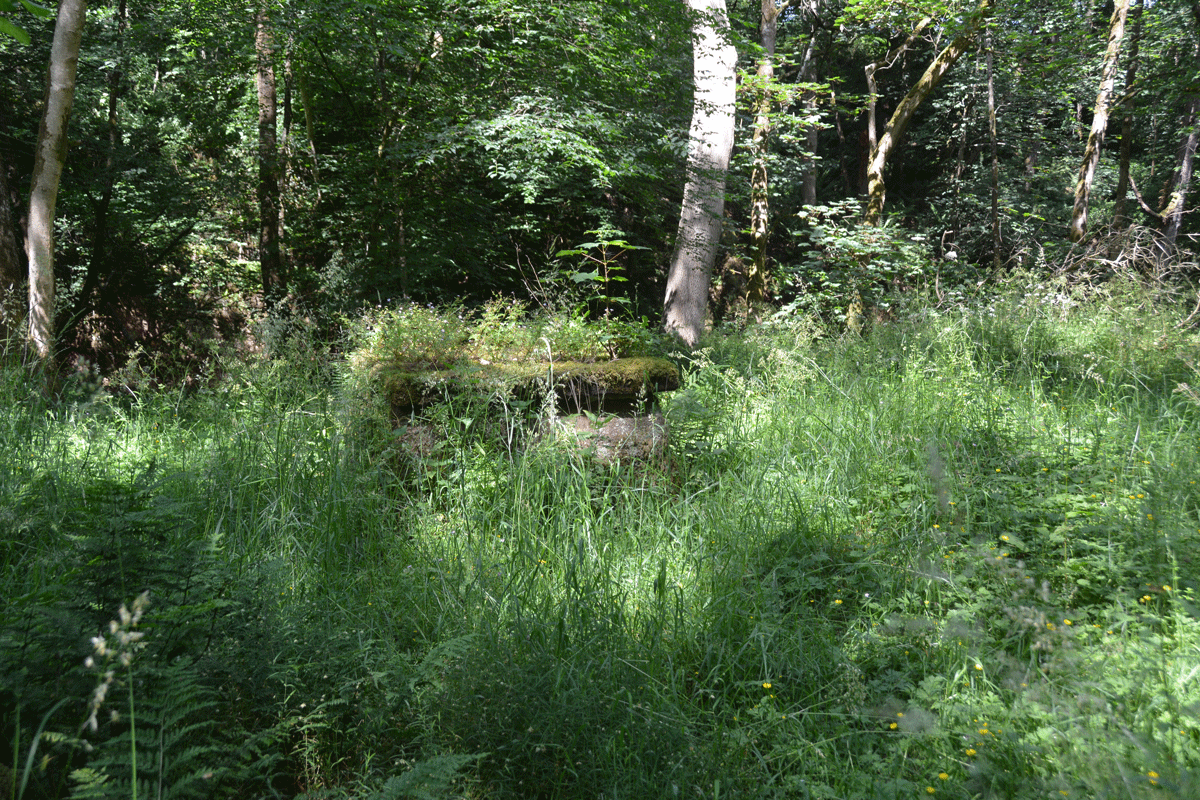
St Michael's Well (Shawk) submitted by Anne T on 10th Jul 2022. Looking back towards the footpath down through the wood (approached from the western side of the woodland).
(View photo, vote or add a comment)
Log Text: St Michael's Well, Shawk: Situated in a very lovely, heavily wooded area, to the east of a stream, Chalk Beck, which has stepping stones over it (these appear to move and be replaced when the stream floods, as there are several sets).
There is no mention on Pastscape or HE, although the HE map search shows a ‘W’ at the location of the well.
To reach the well, we parked on the grass verge at NY 33234 47664, and walked down the (private?) lane leading first south, then largely eastwards, past a number of properties, including the first which is called ‘Farthings’. At NY 33679 47362, the footpath carries on eastwards, through a gate; there is a private road which continues to the south. Our OS map indicated the well was nearer a footpath which started at NY 33653 47097, and which ran largely eastwards, but after 150m or so, it became so overgrown, we turned back.
We proceeded down the marked footpath at NY 33679 47362, where there are now a couple of wooden stables/sheds. There is an old hollow way which runs alongside the western side of the wood here, and we continued along this, through another gate, and followed the path which ran downhill, with a steep gorge to our right hand side. This path winds downhill, eventually coming to some stones laid across the course of Chalk Beck. We gingerly crossed this (wouldn’t like to try when the river is in flood or after it had been raining heavily). The well is immediately to our right hand side, about 20m to the east of the beck, largely hidden by tall grass and bracken.
The well structure is stone, with an opening in the top. The well was about 1/3 full of water, although we didn’t try and sample the water, as someone had thrown in a beer/lager can (a real shame). No visible signs of any ornamentation on the well housing.
The bedding planes on what we thought are red sandstone here were very clear, with a cliff on the western side of the river. Impressive!
St Oswald's Church (Dean)
Trip No.184 Entry No.3 Date Added: 31st Jul 2022
Site Type: Rock Art
Country: England (Cumbria)
Visited: Yes on 24th Jul 2022. My rating: Condition 3 Ambience 4 Access 5
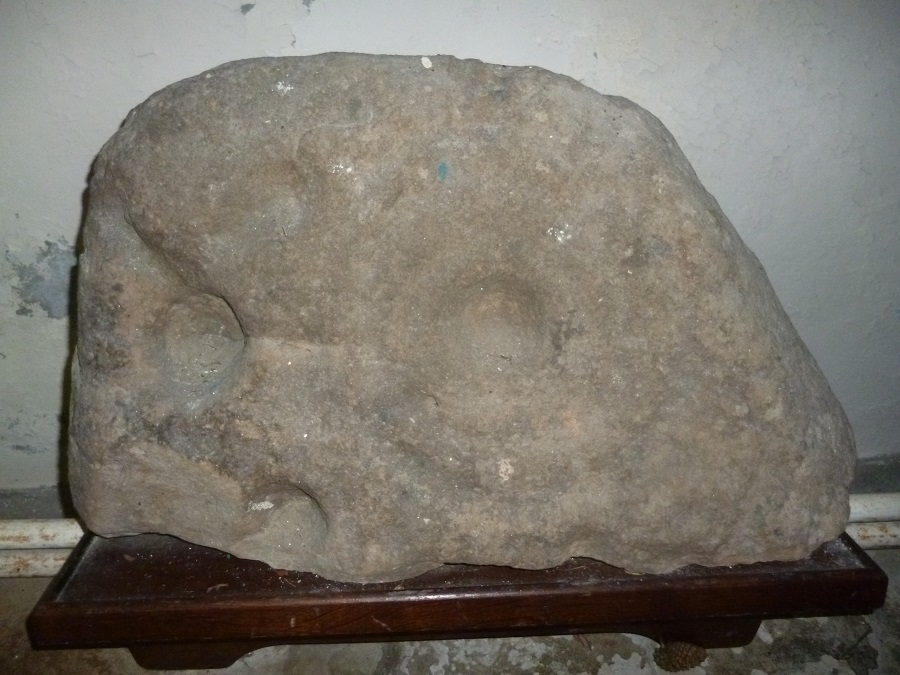
St Oswald's Church (Dean) submitted by SumDoood on 7th Mar 2018. The church is a most unusual and, I'd suggest, attractive building, C12th in origin, or older? Enter through the main door and turn right to find the carved boulder a few yards away. Taken 18-02-2018 and viewed from straight ahead.
(View photo, vote or add a comment)
Log Text: St Oswald's Church (Dean): Having left St Michael and All Angels at Isel, we visited the well in Eaglesfield and tried to find the Singing Well just outside Deanscales. The latter we could see over the hedge, but were unable to gain access to the field it sits in from the road. Parking by the lych gate of the church, walking along the southern side of the church, the preaching cross is easily visible, sitting on what looks like the base of a large market cross, with seven steps. The cross at the top is topped by a 'modern' (18th century) sundial.
We spent some considerable time in the church with the notes provided, tracking and photographing the medieval grave slabs that were visible. Enjoyed this visit.
Long Meg And Her Daughters
Trip No.185 Entry No.2 Date Added: 21st Aug 2022
Site Type: Stone Circle
Country: England (Cumbria)
Visited: Yes on 7th Aug 2022. My rating: Condition 4 Ambience 4 Access 4
Long Meg And Her Daughters submitted by Iain_P on 12th Aug 2017. Another. It was the only sun we saw all week!
(View photo, vote or add a comment)
Log Text: Long Meg and Her Daughters: We walked along the quiet, shady old hollow ways from St Michael's and All Angels, Addingham to Long Meg and her daughters, coming across a well by the side of the track, plus a solitary standing stone in a field just north of Long Meg. The latter was too close to the field boundary to be a rubbing stone. It wasn't marked on the OS map, nor is it mentioned on the Historic England map search or the entry for Long Meg.
We took my daughter-in-law, son and their two dogs along, and they were amazed it was 'a proper stone circle'. The base of Long Meg itself is currently being used as a shrine, with people leaving offerings even as we walked up to this stone - including flowers, key rings and even a pair of sunglasses!
The rock art on Long Meg stood out well in the bright sunlight. The site was very busy today, and the field full of large cattle, who fortunately kept their distance.
Giants Cave Holy Well (Edenhall)
Trip No.188 Entry No.3 Date Added: 15th Sep 2022
Site Type: Holy Well or Sacred Spring
Country: England (Cumbria)
Visited: Saw from a distance on 13th Sep 2022. My rating: Condition 1 Ambience 4 Access 3
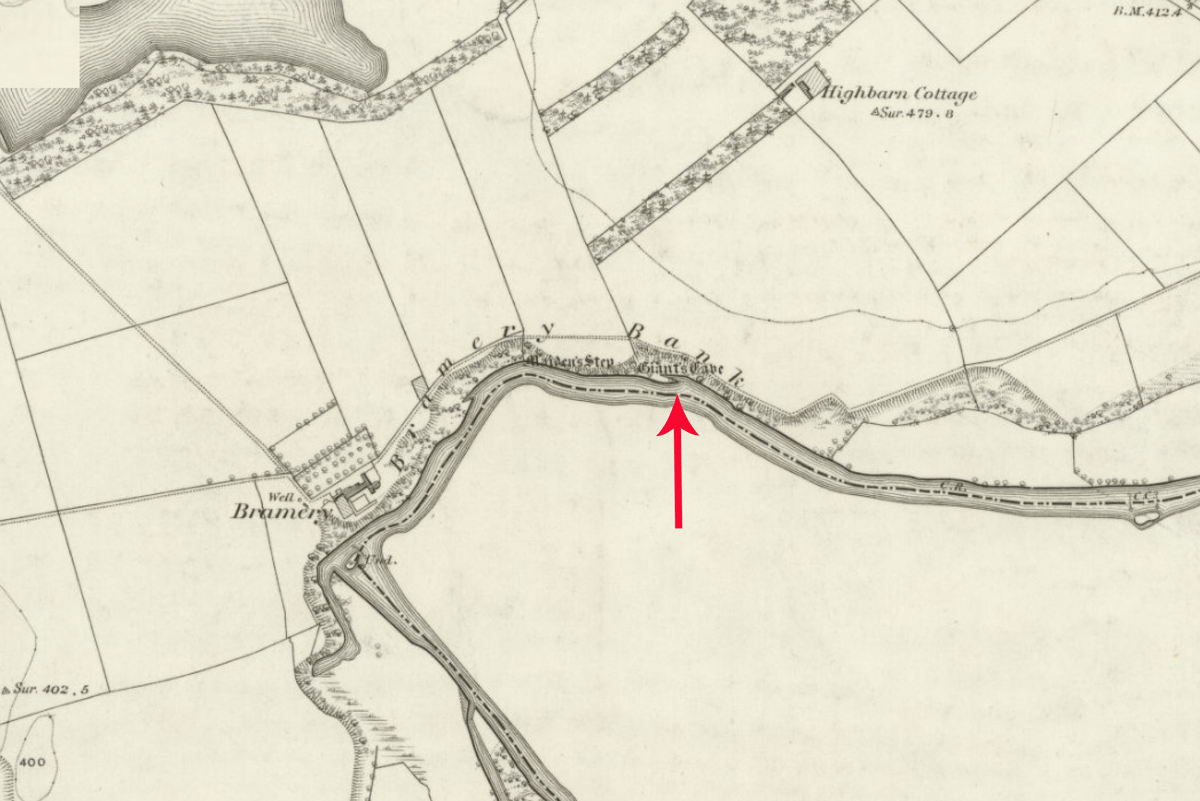
Giants Cave Holy Well (Edenhall) submitted by Anne T on 8th Sep 2022. The exact location of this well is not known. It could be either north or south of the River Eamont, in the vicinity of Giant's Cave (marked with a red arrow). Shared under the terms of the National Library of Scotland Creative Commons Attribution-NonCommercial-ShareAlike 4.0 International (CC-BY-NC-SA) licence. See Sheet Cumberland LIX.2.
(View photo, vote or add a comment)
Log Text: Giant's Cave Holy Well: Having walked to St. Ninian's Church, Ninekirks, and wandered around the site of St Ninian's preconquest monastery, it was only a short walk northwards across the field towards the location of the Giant's Cave and the River Eamont.
There was no sign of the well on the south side of the river, and the river was too big, wide and fast flowing to cross to get to the Giant's Cave, so we tried to spot it from afar.
This section of the river is dominated by red sandstone cliffs, with heavy tree cover, so it wasn't really possible to spot either the cave or the well.
The photographs show approximate locations for the well, given the 'vague' grid reference. Goodness knows how those Victorian revellers got to the cave, but there are beaches along the river, and a beautiful meadow on the south of the river for celebrations at the well to have taken place at.
St Ninian's Church (Ninekirks)
Trip No.188 Entry No.1 Date Added: 18th Sep 2022
Site Type: Ancient Cross
Country: England (Cumbria)
Visited: Yes on 13th Sep 2022. My rating: Condition 3 Ambience 4 Access 3
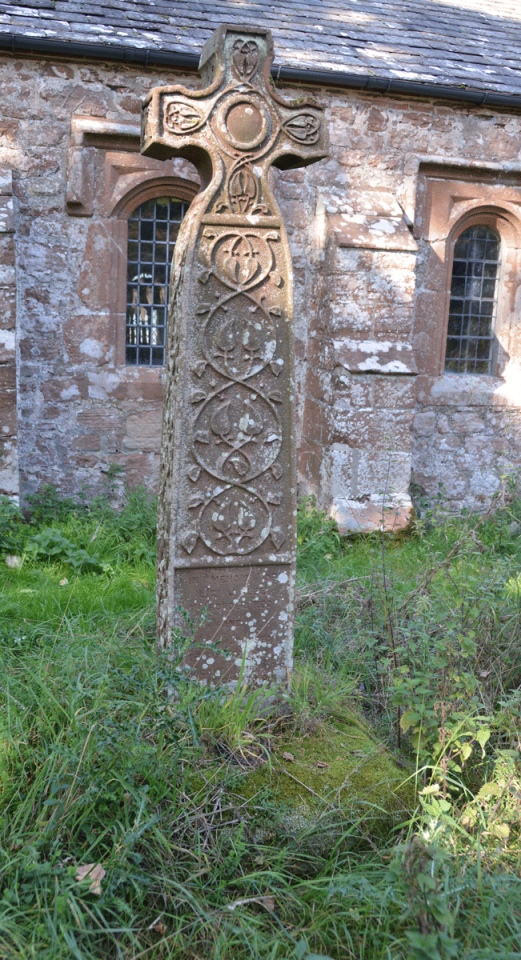
St Ninian's Church (Ninekirks) submitted by Anne T on 18th Sep 2022. Again, the cross base can hardly be seen for the tall grass covering it. Topped by a modern cross shaft and head (a modern grave marker), the cross base sits a few metres south of the nave.
(View photo, vote or add a comment)
Log Text: St Ninian's Church, Ninekirks: We parked in a very small car park which is at the start of a green lane/permissive footpath, at NY 55815 28944. This was quite tricky to spot as the entrance to the car park is small and hidden by tall grass.
The permissive footpath initially leads us a gentle slope at the northern side of a very recently ploughed field, with the River Eamont downslope to our left. The path then turns northwards, still with a steep drop down to a loop of the river, but with pasture to our right. The sheep here were so large they looked like calves.
Through the trees, we could see a large tower attached to a large building, so it came as a bit of a shock to drop down to river level and see the church was so small. It turned out that the building we could see was on top of a hill on the northern side of the river.
Whilst there was no church guide book, the notes left by the Churches Conservation Trust were very helpful.
Beautiful spot, and well worth the walk.
Penrith Museum
Trip No.189 Entry No.1 Date Added: 25th Feb 2023
Site Type: Museum
Country: England (Cumbria)
Visited: Yes on 13th Oct 2022. My rating: Condition 3 Ambience 4 Access 4
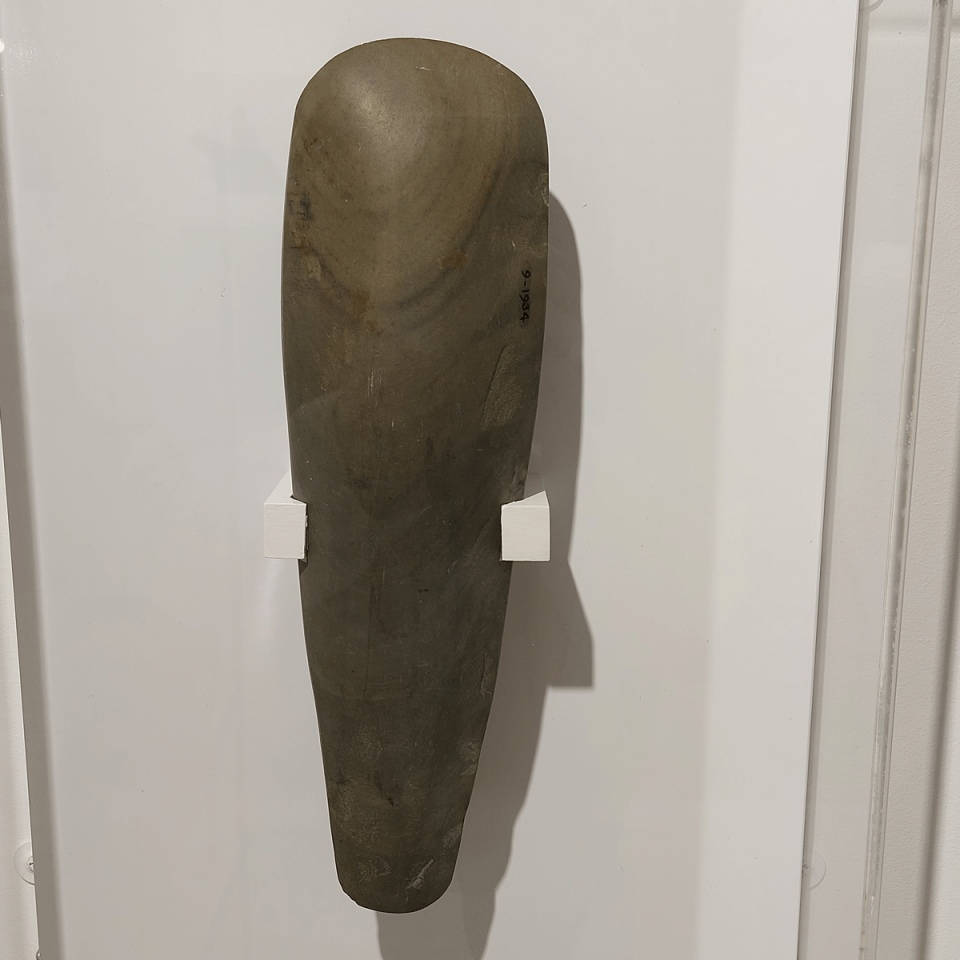
Penrith Museum submitted by Anne T on 25th Feb 2023. This polished late Neolithic Stone Axe was found in Botcherby (the village in which I now live), and comes from the Tullie House Museum collection.
(View photo, vote or add a comment)
Log Text: Penrith Museum: With relatively few trains running between Penrith and Carlisle, and recovering from a broken shoulder, this was of necessity a brief, but reasonably interesting visit. Only a relatively small museum, it has a surprising number of exhibits, although not displayed in any cohesive way, and with frustratingly little information about the items on display. However, I was made very welcome by the staff (volunteer?) members manning the reception desk.
I asked permission to take photographs of some of the exhibits, particularly the cross base, and this was readily granted, providing I didn't use flash. I would go back for another look next time I'm in Penrith, feeling better, and able to carry my proper camera with me, rather than using my mobile phone. Am planning on going back in the not too distant future.
The Castles
Date Added: 4th Aug 2014
Site Type: Stone Fort or Dun
Country: England (County Durham)
Visited: Yes on 3rd Aug 2014. My rating: Condition 3 Ambience 4 Access 4

The Castles submitted by durhamnature on 24th Aug 2012. View from inside The Castles. 1903 image of archaeological investigation.
Site in County Durham England
(View photo, vote or add a comment)
Log Text: We’d come across mention of this site from Time Team Series 15 episode 11 (“5000 tons of stone”) in 2007, and noted it because it was a site relatively local to us. Being late on a windy, but sunny, Sunday afternoon, and wanting to go out somewhere without going far, we decided to head off to Hamsterley to see if we could find this site.
Following the signs for Hamsterley village from the A68, we went through the village along Saunders Avenue, turning first right up Bedburn Road when almost through the village, then first right again along Howlea Lane. I didn’t measure the distance from Hamsterley village, but it is at least several kilometres along this lane. West Shipley Farm doesn’t have a sign outside, but having spotted a sign for Shipley Moss Farm, we knew we were close.
West Shipley Farm is the next farmhouse on the left hand side of the road, and has a wide entrance to the farm track, so we bumped up on one side. The track goes past the farmhouse, then a stile crosses a stone wall (broken right hand post on the far side, so be careful – having fallen heavily during a walk the weekend before, I ended up going back to the gate to the field and walking around), and down hill to what I believe is the Harthorpe Beck valley below.
To the left hand side of the track, there is a modern curving stone wall with a wooded area behind. Between the trees, we could see tantalising glimpses of hefty stone walls. Following the modern stone wall, there is a gate towards the southern end of the field, at approximately grid reference NZ 10269 33059, which took us straight into the un-farmed field containing The Castles.
This is certainly an intriguing site. We gained access by walking across the ditch (not deep in the south west corner) and clambering up a fallen section of wall in the same area – following tracks where other people have done this).
Once inside the Castles, you are immediately within a large stone-built enclosure, away from the wind and very, very quiet and peaceful. There are vast dry stone walls, largely tumbled, but with the lower courses very much in tact. Having walked around the inside of the walls, there appears to be only one entrance, to the east of the site, and this contains a ‘guard room’, or small room, built within the wall itself. A ditch runs around the whole exterior of The Castles, although there is enough flat land between the exterior stone walls and the ditch to walk around the circumference of the walled area (avoiding trees occasionally). The eastern entrance leads down to a stream, which helps to form the eastern boundary.
The site itself is on a slope, half way down the hillside, somewhat similar to Maiden Castle in North Yorkshire, but rather than having a levelled interior like Maiden Castle, the site itself slopes downhill to the stream below, which would make no sense if the site had been occupied. However, the site was wooded and overgrown, so it was very difficult (virtually impossible) to make out any internal ground features.
I went onto the Wessex Archaeology web site when I returned home, and downloaded their archaeological evaluation and assessment for the site. They note that the site is likely to be iron age, although they had very few (virtually no!) finds, and is of rhomboidal, describing an area some 81.26m (west)/85.6m (east) by 65.83m (north)/79.5 m (south), with the wall in the east being thickest – 7m wide at the base.
Certainly enigmatic!
Hunstanworth Moor north
Trip No.42 Entry No.4 Date Added: 29th Aug 2017
Site Type: Standing Stone (Menhir)
Country: England (County Durham)
Visited: Yes on 28th Aug 2017. My rating: Condition 3 Ambience 3 Access 5

Hunstanworth Moor north submitted by HarperFox on 20th Jul 2014. This is the northernmost of the two stones.
(View photo, vote or add a comment)
Log Text: Hunstanworth Moor North, Townhead: Being the day of the Blanchland and Hunstanworth Show, this road was very busy, and it was difficult to stop as the road was narrow and there were no obvious lay-bys or pull-off points (there being a nice ditch at the western side of the road and a steep bank up to the field on the east).
Spotted this stone as we were passing by on the way to the stone approx. 575m south and retraced our steps to photograph it.
Again, after having done searches on the internet, not been able to find out anything about it, like it’s ‘partner’ further up the hill.
St Peter's Church (Bishopton)
Trip No.56 Entry No.1 Date Added: 16th Oct 2017
Site Type: Ancient Cross
Country: England (County Durham)
Visited: Yes on 15th Oct 2017. My rating: Condition 2 Ambience 4 Access 5
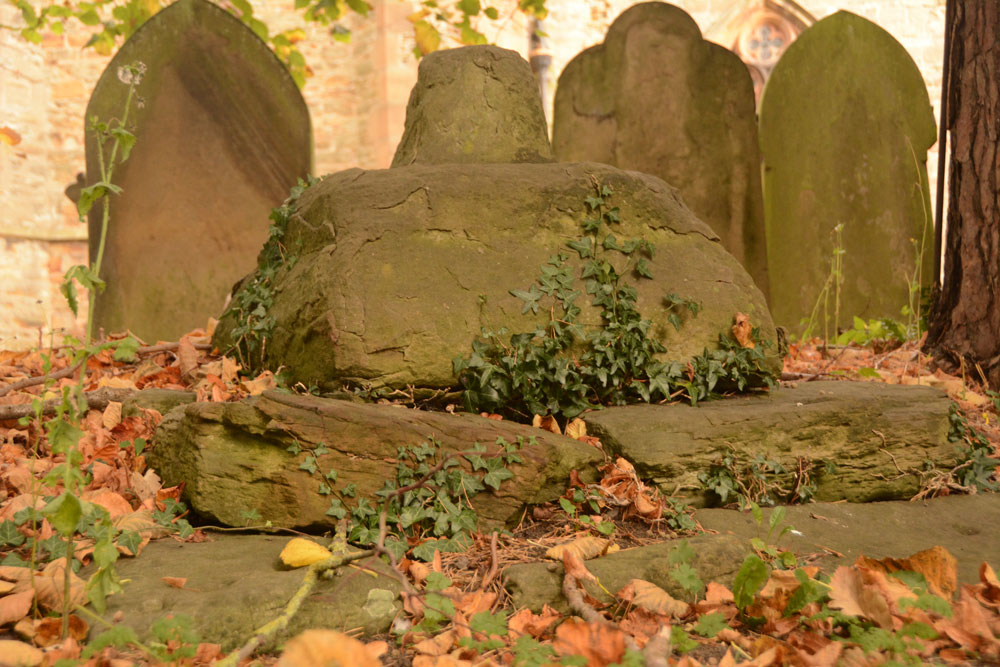
St Peter's Church (Bishopton) submitted by Anne T on 16th Oct 2017. Standing next to the churchyard wall which runs along High Street, looking over the wall to the cross base, socket stone and remains of the shaft.
(View photo, vote or add a comment)
Log Text: Medieval Cross in St. Peter's Churchyard, Bishopton: Driving into Bishopton, I realised looking at the cottages and houses that this was a very old village, and had it not been for all the parked cars, it would have been very picturesque.
The church was locked so we couldn’t go in, but the remains of this cross was visible near the edge of the churchyard. It was easier to photograph it from the road, looking over the wall.
I didn’t photograph the replacement village cross, in the very small village green, near the wall memorial, as I thought it was modern, and we didn’t stop after looking at the earthworks nearby.
Escomb Cross
Date Added: 21st Sep 2014
Site Type: Ancient Cross
Country: England (County Durham)
Visited: Yes on 18th Sep 2014. My rating: Condition 5 Ambience 5 Access 5
Escomb Cross submitted by Thorgrim on 15th Jan 2004. Fragment of a later Saxon cross showing an eagle. (9th century?)
In the porch of Escomb Church.
(View photo, vote or add a comment)
Log Text: Escomb Saxon Church, Saxon Green, Escomb, Northumberland: This church is well worth a visit as it is a showcase for simple, understated architecture with an enormous ambience of history and worship. Peaceful, cool and reflective, Escomb is said to be ‘the most complete Anglo-Saxon Church in England’ and I’d agree with this. The site is said to date from between 650 to 690 AD and is sited at the heart of this tiny village 2km west of Bishop Auckland. The church is kept locked, but the key is kept on a hook outside the door of a property immediately behind the church and is readily accessible.
I’ve been here twice before in 2007; once just to say I’d been here; the second time to meet a colleague at The Saxon Inn across the road for a pre-meeting on the way to a conference in Durham, and popped in. But until today, I’ve never really stopped to look, sit and take in the atmosphere and the simplicity and beauty that goes back to Saxon times (and perhaps beyond?).
Having found a brilliant resource on the internet (The Corpus of Anglo-Saxon Stone Sculpture on Durham University’s web site), today’s visit was particularly to look at the Anglo-Saxon cross shafts in the porch and re-visit the rest of the Anglo-Saxon artefacts I’d seen, but not really appreciated on previous visits - the inscribed Saxon cross on the wall between the nave and the sanctuary (just behind the pulpit), the Saxon grave marker behind the altar, the Roman inscriptions and the Saxon architecture and the sundial on the exterior south wall.
Having spent well over an hour here, I drove over to St Andrew’s Church in Aycliffe village for another ‘feast’ of Anglo-Saxon artefacts.
